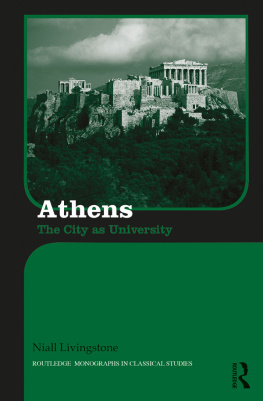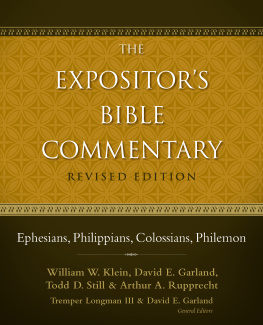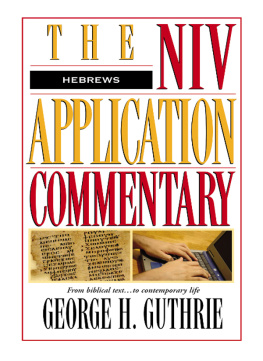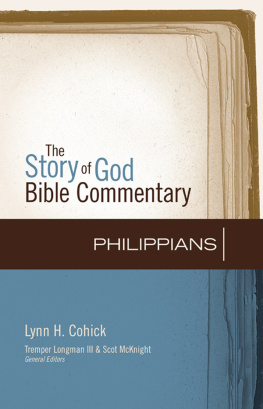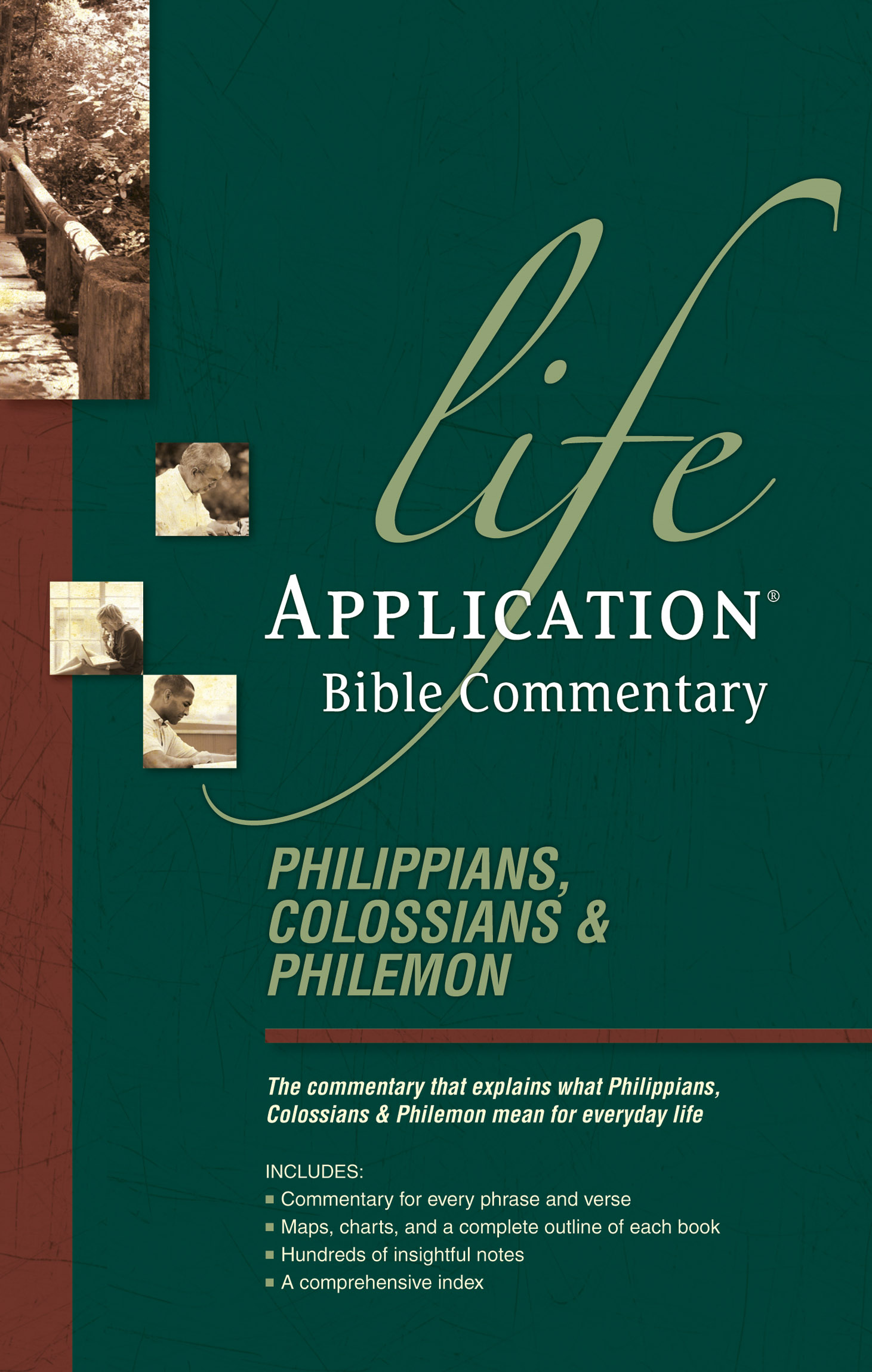Visit Tyndale online at www.tyndale.com.
Life Application Bible Commentary: Philippians, Colossians & Philemon
Copyright 1995 by The Livingstone Corporation. All rights reserved.
Contributing Editors: James C. Galvin, Ed.D., and Ronald A. Beers
Cover photograph of bridge and path copyright by Alyn Stafford / iStockphoto. All rights reserved.
Cover photographs of woman with a laptop and man holding a pen copyright by Dan Wilton / iStockphoto. All rights reserved.
Cover photo of man reading copyright by Ronnie Comeau / iStockphoto. All rights reserved.
Interior illustrations of broken chain (Philippians), tree with roots (Colossians), and laurel wreath (Philemon) copyright 2004 by Tracy Walker. All rights reserved.
Scripture quotations marked NIV are taken from the Holy Bible, New International Version, NIV. Copyright 1973, 1978, 1984 by Biblica, Inc. Used by permission. All rights reserved worldwide.
Scripture quotations marked NKJV are taken from the New King James Version. Copyright 1979, 1980, 1982 by Thomas Nelson, Inc. Used by permission. All rights reserved.
Scripture quotations marked NRSV are taken from the New Revised Standard Version of the Bible, copyright 1989, Division of Christian Education of the National Council of the Churches of Christ in the United States of America. Used by permission. All rights reserved.
(No citation is given for Scripture text that is exactly the same wording in all three versionsNIV, NKJV, and NRSV.)
Scripture quotations marked KJV are taken from the Holy Bible, King James Version.
Scripture verses marked NEB are taken from The New English Bible, copyright 1970, Oxford University Press, Cambridge University Press.
Scripture quotations marked NLT are taken from the Holy Bible, New Living Translation, copyright 1996 by Tyndale House Foundation. Used by permission of Tyndale House Publishers, Inc., Carol Stream, Illinois 60188. All rights reserved.
Scripture verses marked TEV are taken from the Good News Bible: The Bible in Todays English Version, copyright 1966, 1971, 1976 by the American Bible Society.
TYNDALE, Life Application, New Living Translation, NLT, Life App, the Life App logo, and Tyndales quill logo are registered trademarks of Tyndale House Publishers, Inc.
Library of Congress Cataloging-in-Publication Data
Philippians, Colossians, and Philemon / Bruce B. Barton... [et al.].
p. cm. (Life application Bible commentary)
Includes bibliographical references and index.
ISBN 978-0-8423-2974-3 (pbk)
1. Bible. N.T. PhilippiansCommentaries
2. Bible. N.T. ColossiansCommentaries
3. Bible. N.T. PhilemonCommentaries
I. Barton, Bruce B. II. Series.
BS2705.3.P48 1995
227dc2095-6670
Build: 2020-10-01 15:35:45 EPUB 3.0
FOREWORD
The Life Application Bible Commentary series provides verse-by-verse explanation, background, and application for every verse in the New Testament. In addition, it gives personal help, teaching notes, and sermon ideas that will address needs, answer questions, and provide insight for applying Gods Word to life today. The content is highlighted so that particular verses and phrases are easy to find.
Each volume contains three sections: introduction, commentary, and reference. The introduction includes an overview of the book, the books historical context, a timeline, cultural background information, major themes, an overview map, and an explanation about the author and audience.
The commentary section includes running commentary on the Bible text with reference to several modern versions, especially the New International Version and the New Revised Standard Version, accompanied by life applications interspersed throughout. Additional elements include charts, diagrams, maps, and illustrations. There are also insightful quotes from church leaders and theologians such as John Calvin, Martin Luther, John Wesley, A. W. Tozer, and C. S. Lewis. These features are designed to help you quickly grasp the biblical information and be prepared to communicate it to others.
The reference section includes a bibliography of other resources and an index.
GENERAL INTRODUCTION
Letters of all sizes and purposes flood our homes and businesses, filling our mailboxes and lives with envelopes, paper, and requests for urgent responses. Written, stamped, deposited, collected, sorted, routed, bundled, and delivered, millions of these epistles travel daily from senders to receivers with hi-tech efficiency. These days, most of our mail falls into the junk category: ads, contests, political endorsements, polls, newsletters, insurance and credit card enticements, and financial appeals for a variety of causes. Monthly bills also march in the postage parade, and occasionally official correspondence, business letters, and checks are in the mail. Most of these envelopes are quickly dispatched, with their contents relegated to the appropriate places (often the circular file).
Personal letters break through this stack of unwanted paper. Enthusiastically grasping these grand exceptions, we rip open the envelopes and eagerly read each line (and between the lines). Birthday cards, postcard vacation notes, annual family reports, letters from camp, encouragements from friends and relatives, and love letters all receive our full attention.
Twenty centuries ago, before computer labels, color separations, zip and bar codes, high-speed presses, electronic sorting, and photocopy and fax machines, people wrote to each other. Hand delivered by friends or special couriers, these letters carried greetings, instructions, encouragements, and personal words. With no flood of junk mail competing for attention, the epistles were received with joy and were shared with others.
As Paul traveled throughout the Roman Empire preaching the gospel, teaching new converts, and establishing churches, he developed close relationships. To keep in touch with these dear friends and to instruct them further in biblical theology and Christian living, he would write letterspersonal epistles. Paul even wrote to believers in cities that he had not yet visited, but whom he knew needed a word of instruction, encouragement, or correction. God used Paul and many of his letters, now contained in the New Testament, to communicate his message to those first-century believers and beyondreaching to us today.
The three of these epistles in this volume, Philippians, Colossians, and Philemon, provide an interesting collection of Pauls writings. Although widely divergent in purposes and content, each one comes from Pauls heartfor Christ, for the church, and for individual believers. And imagine the joy with which these letters were receivedpersonal words from their beloved teacher, mentor, and friend.
AUTHOR
Paul: apostle of Christ, courageous missionary, gifted teacher, articulate apologist, and Christian statesman.
Having received an excellent secular and religious education (Acts 22:3), Paul was destined for leadership in Jerusalem Judaism. We first read of Paul in Acts at the stoning of Stephen, a courageous and outspoken deacon in the Jerusalem church. Paul collected the coats of the executioners (Acts 7:58) and approved of Stephens death (Acts 8:1). Soon afterward, Paul persecuted followers of Christ, capturing them and throwing them into prison (Acts 8:3; 22:4; Galatians 1:13-14). A Pharisee and influential member of the Jewish ruling council (the Sanhedrin), he voted to have these followers of the Way put to death (Acts 26:5, 10). As a zealous defender of the faith, Paul found great favor among the religious establishment. But his fast track took a U-turn on the road to Damascus, where he was confronted by the Lord (Acts 9:1-6; 22:5-10; 26:12-18).


